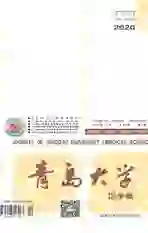喙突解剖学测量及相关性研究
2020-09-29任中楷汪建于腾波
任中楷 汪建 于腾波

[摘要] 目的 通过系统化测量喙突形态数据,分析数据之间相关性,探究国人喙突形态,为临床诊治肩关节疾病提供依据。方法 选取青岛大学解剖实验室完整成对肩胛骨标本共50对(100只),分别测量喙突水平部长度、宽度、厚度,喙突水平部中点宽度、厚度,喙突垂直部长度、宽度、高度,喙突尖至盂上结节距离和喙突尖至关节盂最短距离。结果 肩胛骨标本的喙突水平部长(41.60±4.17)mm、宽(14.94±2.32)mm、厚(8.54±1.41)mm,喙突水平部中点宽(14.68±1.95)mm、厚(9.69±1.57)mm,喙突垂直部长(27.94±3.18)mm、宽(10.34±1.74)mm、高(12.09±2.90)mm,喙突尖至关节盂最短距离(20.51±2.89)mm,喙突尖至盂上结节距离(18.58±4.64)mm。上述各项数据左右侧均呈正相关(r=0.601~0.852,P<0.05)。喙突垂直部高度与喙突尖至关节盂最短距离呈正相关(r=0.676,P<0.05)。结论 国人喙突形态部分指标平均数据小于国外样本,不可盲目借鉴国外研究结论,本文结果为国人肩关节疾病的诊断提供了解剖学基础。喙突垂直部高度与喙突尖至关节盂最短距离存在相关性,可为临床上判断喙突下撞击提供解剖学依据。
[关鍵词] 喙突;尸体解剖;运动人体测量学;肩撞击综合征;数据相关性
[中图分类号] R323.42;R684 [文献标志码] A [文章编号] 2096-5532(2020)05-0513-03
doi:10.11712/jms.2096-5532.2020.56.137 [开放科学(资源服务)标识码(OSID)]
[ABSTRACT] Objective To explore the morphology of the coracoid process in the Chinese by systematically measuring morphological data on the coracoid process and analyzing their correlations, and to provide clinical evidence for the treatment of shoulder joint diseases. Methods A total of 50 pairs (100 cases) of scapula specimens were selected and the following morphological parameters were measured: the length, width, and thickness of the horizontal and vertical parts of the coracoid process, the width and thickness of the midpoint of the horizontal part of the coracoid process, the distance between the tip of the coracoid process and the supraglenoid tuberosity, and the shortest distance between the tip of the coracoid process and the glenoid cavity. Statistical analyses were performed to examine the correlations of these morphological parameters. Results For the 100 scapular specimens, the mean length, width, and thickness of the horizontal part of the coracoid process were (41.60±4.17) mm, (14.94±2.32) mm, and (8.54±1.41) mm, respectively; the mean midpoint width and thickness of the horizontal part of the coracoid process were (14.68±1.95) mm and (9.69±1.57) mm, respectively; the mean length, width, and thickness of the vertical part of the coracoid process were (27.94±3.18) mm, (10.34±1.74) mm, and (12.09±2.90) mm, respectively; the mean shortest distance between the tip of the coracoid process and the glenoid cavity was (20.51±2.89) mm; the mean distance between the tip of the coracoid process and the supraglenoid tuberosity was (18.58±4.64) mm. There was a positive correlation between the left and right sides for each parameter (r=0.601-0.852,P<0.05). The length of the vertical part of the coracoid process was also positively correlated with the shortest distance between the tip of the coracoid process and the glenoid cavity (r=0.676,P<0.05). Conclusion The mean values of some morphological parameters of the coracoid process in the Chinese are lower than those of the samples from other countries, and the findings from those samples therefore should not be taken indiscriminately. This study provides an anatomical basis for the diagnosis of shoulder joint diseases in China. The length of the vertical part of the coracoid process is correlated with the shortest distance between the tip of the coracoid process and the glenoid cavity, thus providing an anatomical basis for clinical diagnosis of subcoracoid impingement.
[KEY WORDS] coracoid process; autopsy; kinanthropometry; shoulder impingement syndrome; correlation of data
喙突是從肩胛骨关节盂上侧向上向前外侧突出的钩状骨结构,外科医生通常称之为“肩上的灯塔”,它不仅是人体重要的解剖学标志,也是胸部及上肢重要肌肉的附着点,而且它靠近主要神经血管结构(如臂丛、腋动脉等)。喙突下撞击综合征又称喙突撞击,其定义为喙突对肱骨小结节的侵犯。肱骨小结节是肩胛下肌肌腱止点,肱骨内旋时,肩胛下肌肌腱在经过喙突下空间时受到喙突撞击,经过长期的压迫和磨损,导致肩胛下肌损伤,影响肩关节内旋、内收等功能[1]。国外学者认为在大多数情况下,喙突的高度和长度的变化会导致喙肩弓形态的改变以及肩袖的损伤[2]。前方关节盂缺损是确定肩关节不稳病人治疗方式和预测预后的重要因素之一,因此,术前评估关节盂缺损对于制定最佳治疗方案至关重要[3]。诊断关节盂缺损的方法包括术前X线片、三维重建计算机断层扫描和术中关节镜检查[4]。但上述方法依然无法复原缺损的关节盂,影响对关节盂缺损程度的评估。到目前为止,国外已有文献对关节盂与周围结构的关系进行了探讨,以评价关节盂缺损程度[4-5]。本研究系统性测量了成对喙突以及关节盂的形态数据,并有针对性地分析了数据间的相关性,以期为肩关节疾病的临床治疗提供指导。
1 资料与方法
1.1 一般资料
于青岛大学解剖实验室选取50对(共100只)成人肩胛骨标本,左、右侧各50只。标本纳入标准:①标本编号清楚无误,每对肩胛骨标本均来自同一成人骨骼;②肩胛骨标本无污染、缺损。
1.2 研究方法
将100只肩胛骨标本成对编号标记后,用数字游标卡尺(精确度为0.01 mm)分别测量喙突水平部长度、宽度、厚度,喙突水平部中点宽度、厚度,喙突垂直部长度、宽度、高度,喙突尖至关节盂最短距离,喙突尖至盂上结节距离(图1)。以上指标均测量3次,取平均值。分析上述各项指标左右侧的相关性,以及喙突垂直部高度和长度与喙突尖至关节盂最短距离的相关性。
1.3 统计学处理
采用SPSS 25.0软件进行统计学分析。计量资料以±s表示,左右侧数据比较采用两样本比较的t检验;各指标之间的相关性检验采用Pearson相关性分析。以P<0.05为差异有统计学意义。
2 结 果
本文肩胛骨标本各项指标的平均值:喙突水平部长度(41.60±4.17)mm,喙突水平部宽度(14.94±2.32)mm,喙突水平部厚度(8.54±1.41)mm,喙突水平部中点宽度(14.68±1.95)mm,喙突水平部中点厚度(9.69±1.57)mm,喙突垂直部长度(27.94±3.18)mm,喙突垂直部宽度(10.34±1.74)mm,喙突垂直部高度(12.09±2.90)mm,喙突尖至关节盂最短距离为(20.51±2.89)mm,喙突尖至盂上结节距离为(18.58±4.64)mm;关节盂平均长径(35.26±3.55)mm,关节盂平均短径(26.11±3.20)mm。喙突各项指标左右侧比较,除了喙突垂直部长度(t=3.97,P<0.05)外,其他指标差异均无显著性(P>0.05)。见表1。相关性分析显示,喙突左右侧各项指标均呈正相关(r=0.601~0.852,P<0.05)。喙突垂直部高度与喙突尖至关节盂最短距离呈正相关(r=0.676,P<0.05),而喙突垂直部长度与喙突尖至关节盂最短距离无相关性(P>0.05)。
3 讨 论
喙突及关节盂是肩胛骨的重要解剖结构,可指导大部分肩关节疾病的诊断与治疗。随着微创手术技术的发展,肩关节镜技术使得疾病的诊治变得更加便捷与精确,这要求外科医生对肩关节的结构必须有更清晰的认识。目前,国外针对喙突及关节盂形态数据已有大量研究,但研究样本大多来自欧洲、美洲等;而国内相关研究中,鲜有研究系统性地测量大量成对肩胛骨并进行左右侧对比和相关性分析。本研究结果显示,国人肩胛骨样本部分指标数据小于国外样本[6-9]。因此,在肩关节疾病的诊治中,不可生搬硬套国外的研究结论,系统性研究国人肩胛骨形态对肩关节疾病的诊治很有必要。本研究对50对肩胛骨进行配对分析显示,左右侧肩胛骨的各项数据对比,除喙突垂直部长度外,差异均无统计学意义。此结果与国内相关文献报道不一致[10],可能由于本研究测量样本量较大,且均为左右侧成对测量,有较强的可比性。本研究又通过计算各项指标左右侧相关性显示,各项指标左右侧均呈较强的正相关性,表明临床上可以通过观察一侧肩胛骨来判断对侧肩胛骨的形态大小,并可将其应用于临床肩关节骨缺损修补及3D打印。
目前国内外已有许多文献证实,喙突下空间形态的改变是造成喙突下撞击的重要诱因[2,11]。有研究者认为,尽管喙肩弓包括肩峰部、喙肩韧带以及喙突,但喙突的形态是改变喙肩弓体积和形状的主要原因[11]。国外已有尸体标本研究结果显示,喙突尖至盂唇的最小距离为21.5 mm[5]。与之相似,本研究喙突尖至关节盂最短距离为(20.51±2.89)mm。RENOUX等[2]指出,在大多数情况下,喙突的高度和长度发生变化是导致喙肩弓和肩袖之间空间改变的原因。基于此,本研究测量了喙突垂直部高度和长度与喙突尖至关节盂最短距离的相关性,结果显示,喙突垂直部高度与喙突尖至关节盂最短距离存在正相关性。表明喙突垂直部越高,喙突尖至关节盂最短距离越长,喙突下空间越大,进而表明喙突垂直部越高,罹患喙突下撞击的概率越小。
综上所述,本研究明确了国人喙突的部分形态数据小于国外数据,表明在临床手术过程中不可盲目借鉴国外数据。本文结果为国人肩关节疾病的诊断提供了解剖学基础。本文结果还表明,喙突垂直部越高,罹患喙突下撞击的概率越小;可通过观察一侧肩胛骨来判断对侧肩胛骨的形态大小,而这可应用于临床肩关节骨缺损修补及3D打印等方面。
[参考文献]
[1] FERRICK M R. Coracoid impingement: a case report and review of the literature[J]. The American journal of sports me-dicine, 2000,28(1):117-119.
[2] RENOUX S, MONET J, PUPIN P, et al. Preliminary note on biometric data relating to the human coraco-acromial arch[J]. Surg Radiol Anat: SRA, 1986,8(3):189-195.
[3] YAMAMOTO N, ITOI E, ABE H, et al. Effect of an ante-rior glenoid defect on anterior shoulder stability: a cadaveric study[J]. Am J Sports Med, 2009,37(5):949-954.
[4] SHIJITH K P, SOOD M, SUD A D, et al. Is CT scan a predictor of instability in recurrent dislocation shoulder[J]? Chin J Traumatol, 2019,22(3):177-181.
[5] THAM A, PURCHASE R, KELLY J D. The relation of the coracoid process to the glenoid: an anatomic study[J]. Arthroscopy, 2009,25(8):846-848.
[6] POLGUJ M, JEDRZEJEWSKI K S, PODGRSKI M, et al. Correlation between morphometry of the suprascapular notch and anthropometric measurements of the scapula[J]. Folia Morphol, 2011,70(2):109-115.
[7] RIOS C G, ARCIERO R A, MAZZOCCA A D. Anatomy of the clavicle and coracoid process for reconstruction of the coracoclavicular ligaments[J]. Am J Sports Med, 2007,35(5):811-817.
[8] SALZMANN G M, PAUL J, SANDMANN G H, et al. The coracoidal insertion of the coracoclavicular ligaments an anatomic study[J]. American Journal of Sports Medicine, 2008,36(12):2392-2397.
[9] BHATIA D N, DE BEER J F, DU TOIT D F. Coracoid process anatomy: implications in radiographic imaging and surgery[J]. Clin Anat, 2007,20(7):774-784.
[10] 張磊,陈亨树,祁冀,等. 喙突的解剖形态学测量及其临床意义[J]. 中国临床解剖学杂志, 2018,36(6):606-610.
[11] OSTI L, SOLDATI F, DEL BUONO A, et al. Subcoracoid impingement and subscapularis tendon: is there any truth[J]? Muscles Ligaments Tendons J, 2013,3(2):101-105.
(本文编辑 马伟平)
